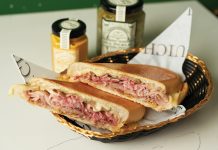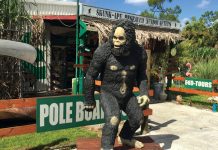
Photograph by Getty Images
Manatees and Mermaids
You could traipse through the Florida wilderness with hiking boots and binoculars, checking off species as you see them. But if you’re short on time and want to see a bunch of wildlife—as I did on a recent midwinter road trip down Florida’s Gulf Coast—you could also just drop by Homosassa Springs Wildlife State Park, a gorgeous subtropical campus beside the Homosassa River. Animals have a storied past on this property, which used to be a private concern called Nature’s Own Attraction, a tourist trap whose exotic holdings included trained animal actors. Nowadays, a better example of Old Florida is just down the highway at Weeki Wachee Springs State Park, which still offers mermaid shows—live mermaids!—twice a day. But linger awhile at Homosassa—it’s less gimmicky, more peaceful.
Today Homosassa Springs, about a third of the way down the Florida peninsula, serves as a refuge for rescued native creatures. A stroll through the park offers a one-stop opportunity to see pelicans swooping and flamingos grooming, a bobcat dozing in the sun, panthers, foxes, roseate spoonbills. Non-native species are few but notable: First, the retirees who live nearby—transplanted, no doubt, from the Ohio habitats of their birth—who spend their mornings power walking a paved path through the forest. (That part’s free; admission to the animal section costs $13.) Second, the oldest hippopotamus in the country, a retired performer named Lu. He’s in his 60s but has not lost his flair for showmanship: Lu has been known to use his tail to fling feces at visitors.
And, of course, there are the manatees lolling in the Homosassa River. Particularly in winter, there’s no better venue for manatee spotting than this area. It boasts of being the only place in Florida where you can swim with them, here at Homosassa or nearby at Crystal River.
This region of the state feels like an in-between space: not as rural as North Florida, not as crowded as places farther down along the coast. Even as you get deeper into the land of seaside condos and Publix-anchored shopping plazas, the natural world is so indomitable that it can’t help but explode through the cracks. So here are a few more suggestions for a Gulf Coast road trip—mostly (once you get there) on foot, mostly away from the beach parties, and out in the wild to the extent possible. But one more recommendation before you leave Homosassa Springs: Stop at Twistee Treat for an ice cream cone.

Orchids and Alligators
Mermaids, retirees, aging animal performers: You’re at the Florida intersection of untamed and improbable, a juncture you’ll encounter again in Tampa—specifically the electric utility. The water used for cooling the Big Bend Power Station is drawn from, and subsequently discharged into, Tampa Bay, where—warmed up—it attracts herds of manatees; Tampa Electric has gamely provided a viewing platform. Fair warning: As you travel south, manatee-viewing opportunities will abate, and the chances of your being eaten by an alligator increase somewhat.
At least this was the opportunity I encountered at the Fakahatchee Strand, a state preserve sandwiched between Naples and the Everglades. For lunch beforehand, the dog and I drove out to Chokoloskee, a sleepy island with one restaurant (the thatch-roofed HavAnna Cafe, serving cubanos, pastelitos, and the like) and a curious history. It’s the place where Edgar Watson, a notorious outlaw of the Florida frontier, was gunned down in 1910 outside Smallwood’s Store, a touristy version of which still exists, selling Seminole crafts and alligator heads and things of that nature. There’s not a strict either-or relationship between land and water in this part of the world: Chokoloskee belongs to the immense archipelago known as the Ten Thousand Islands, and the watery Fakahatchee Strand is part of a vast hydrological system that feeds into the Gulf, flowing underneath the mangroves.
Florida’s largest state park, the Fakahatchee Strand, was the setting for Susan Orlean’s book The Orchid Thief, which was made into the 2002 film Adaptation. I didn’t see the famed ghost orchid that provided the narrative engine of that story, but I did see, somewhat to my consternation—did I mention I had a dog with me?—lots of alligators. We hiked up East Main Tram, said to be the prettiest trail in the preserve. I have been trained on the gatorscapes of the Georgia coast—open marsh, trails on raised embankments—where surprises are rare; so I suppose I brought a little unearned confidence with me, along with, again, a 35-pound dog. But this place is much different: We found ourselves on a narrow path, only a foot or two above the swamp on either side, amid dense tropical jungle.
And we found, on our way back to the car, an alligator sleeping on the trail, blocking our path. From a distance, a standoff ensued. Should I venture to walk past? I hemmed and hawed for about half an hour. After a while, a family of three German tourists approached from the other direction. We spent another half hour hemming and hawing together: They wanted to go their way, I wanted to go mine, but there was an alligator between us. Finally, the Germans—boldly, I thought, for people from a country with no native deadly reptiles as far as I’m aware—came up with a plan: They collected various palm fronds and other organic baffles and, holding the fronds between themselves and the gator, inched past on the trail as far away as they could—like cartoon characters on the ledge of a building. Sensing this was my only opportunity to try to do the same while there were still people around to call an ambulance, I crept past in the other direction, encouraged by the German teen: Walk slowly and don’t look it in the eye, she told me, expertly. Dog in one arm, big chunk of palm in the other, that’s how I got out.

Photograph by Getty Images
Weird Deer
Thus the first priority when I arrived on the Florida Keys later that day was finding someplace to drink a beer, which I did at the homey Islamorada Shrimp Shack, paired with conch salad and a plate of fries. A single two-lane highway cuts through the Keys, which take a few hours to drive end to end. I stayed somewhere in the middle, at a laid-back little resort called Hadley House, where accommodations included free kayak rentals.
The Keys are still cleaning up from Hurricane Ian, as I found the next morning when I set out for Long Key State Park. Part of the hiking trail there was out of commission, though the open areas provided a gorgeous walk among the mangroves. Keep driving southwest and you’ll get to Seven Mile Bridge, an engineering wonder that leads to Bahia Honda Key, which has “the finest beach on the Keys” and the best place to view the sunset over the Gulf, according to a decades-old guidebook I brought with me. The offhand way this was mentioned led me to believe it was a kind of local secret but, if that was ever the case, it isn’t now: When I passed, the state park was full to capacity. On to Big Pine Key, whose attractions are subtler but, to my mind, as enchanting as any sunset. Big Pine Key is ground zero for Key deer, an endangered subspecies of white-tailed deer described by the U.S. Fish & Wildlife Service as “the only large herbivore in the Florida Keys,” though the adjective is relative. These guys measure, on average, less than three feet tall at the shoulders. They’re tiny deer!
Alas, they weren’t out. But the dog and I were happy to explore their strange stomping grounds, an equally singular South Florida habitat called pine rocklands, which is roughly what it sounds like: lonely slash pine growing from a hard limestone ground, with saw palmetto making up much of the underbrush. The fire-adapted landscape is so open that the wind blew across it unbroken. Walking through the trails in the National Key Deer Refuge felt a little like being on the moon, if the moon were hot and scrubby. Two women on bikes told me to come back at dusk to see the deer; I didn’t make it, but I imagine that when I do get back there after hours, I’ll pair my deerspotting with a stop at the 1930s-era No Name Pub, one of the few bars on the island, well-regarded for its pizza, smoked fish dip, and laid-back vibes.

Photograph by Getty Images
Butterflies and Chickens
And then the literal end of the road, Key West, where Mile Marker #0—signifying the end of U.S. Highway 1—can be found at the corner of Fleming and Whitehead streets, right next to an improbably fat, prehistoric-looking kapok tree. Unmolested nature does not exactly abound on this crowded little island, but natural beauty does, as do opportunities to walk around in offbeat places like the City Cemetery and local attractions like the Key West Butterfly & Nature Conservatory (home to 50 or 60 species, plus various colorful birds) and Nancy Forrester’s Secret Garden, a beloved parrot rescue facility. The main thing to do in Key West is just to wander, stopping here and there for daiquiris and photo ops.
And you know what else abounds: wild chickens. For all the spoonbills and gators, chickens may as well be Florida’s state animal. You see them pecking around Ybor City, in Tampa; I once ran into one at a Starbucks drive-thru outside St. Augustine. But the birds of Key West, jungle fowl who trace their lineage to South Asia, possess an unusual beauty: sleek and nimble and iridescent and remarkably unbothered by all the hubbub. Are these chickens too unbothered? Just recently the Key West City Council passed an ordinance forbidding feeding feral fowl. Whether it’ll make any difference, who knows? In Florida—just like in Jurassic Park, come to think of it, and we all know how that ended—life finds a way.
This article appears in our March 2023 issue.













